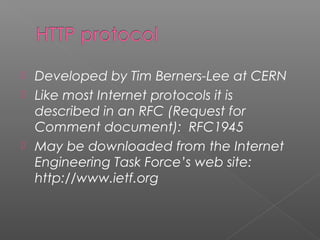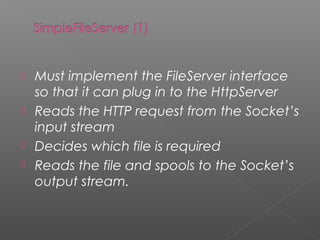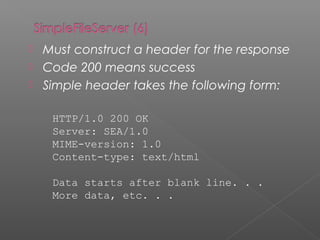A java servers
- 3. To create a simple HTTP server in Java To use the implementation to illustrate a number of advanced Java features: › TCP/IP Sockets and Server Sockets › Interfaces › Software components (more from John later) › Multithreading To show how to create executable server objects (using Sun’s Servlets API)
- 4. Java Network Programming, Elliotte Rusty Harold, O’Reilly and Associates, 1997, ISBN 1-56592-227-1 TCP/IP Network Administration, Second Edition, Craig Hunt, O’Reilly and Associates, 1997, ISBN 1-56592-322-7 The Java Developer’s connection: http://www.javasoft.com/jdc The Javadoc documentation
- 5. Server must be able to process HTTP/1.0 file transfer requests and deliver files Connections are to be made via TCP/IP Must be efficient and prompt Must be simple to understand and elegant in design
- 6. Developed by Tim Berners-Lee at CERN Like most Internet protocols it is described in an RFC (Request for Comment document): RFC1945 May be downloaded from the Internet Engineering Task Force’s web site: http://www.ietf.org
- 7. Some of you may have covered this in the introductory Java course Servers have a listener loop › Loop until the server is shutdown Wait for a client to request a connection Read the details of the client’s request Provide the requested information to the client Here’s the listener loop from our example:
- 8. ServerSocket socket = new ServerSocket(80, 5); public void listen() throws IllegalAccessException, InstantiationException, IOException { for (;;) { System.err.println("HttpServer: waiting..."); Socket s = socket.accept(); FileServer f = createFileServer(); f.dispatch(s); } }
- 9. 2037 80 2037 1583 2037 1583 Client (sid) Server (fred) ServerSocket ss. s = ss.accept() s = new Socket (“fred”, 80) Socket s s.getInputStream() s.getOuputStream() s.getInputStream() s.getOuputStream()
- 10. Good software is designed in a modular fashion avoiding stovepipe designs! This is a form of software components Java has strong support for components Components hide their implementation behind interfaces An interface defines a contract between the supplier/server and the user/client.
- 11. ServerSocket socket = new ServerSocket(80, 5); public void listen() throws IllegalAccessException, InstantiationException, IOException { for (;;) { System.err.println("HttpServer: waiting..."); Socket s = socket.accept(); FileServer f = createFileServer(); f.dispatch(s); } }
- 12. Simplifies client implementation Clients do not need to worry about the implementation details Interfaces encapsulate state of different subsystems ⇒ side effects reduced Define clear boundaries between different teams of programmers Clients can substitute alternative implementations: polymorphism Clients can purchase off the shelf solutions: software components
- 13. Software Component Client Program Interface /ublic class HttpServer { /** Listens indefinitely for transfer requests and creates a server instance for each request. */ public void listen() throws IllegalAccessException, InstantiationException, IOException { for (;;) { /* Block, waiting for a request to occur then spawns a new (anonymous) socket with which to deal with the request. */ System.err.println("HttpServer: waiting..."); Socket s = socket.accept(); /* Create a file server to deal with the new socket. */ FileServer f = createFileServer(); f.dispatch(s); } } public static void main(String[] args) { try { HttpServer htts = new HttpServer("sea.server.ThreadedFileServer"); htts.listen(); } catch (Exception e) { System.err.println("HttpServer: failed due to exception:n" + e); } }
- 14. public interface FileServer { /** This method allows an incoming HTTP request to initiate a file dispatch. The socket will provide an input stream (which is at the beginning) from which an HTTP/1.0 header request may be read.<p> It also provides an output stream on which the request should be delivered. The delivery should have an HTTP/1.0 header prepended. @param s The socket on which a request is being made. Once this method has returned the socket will have been closed by the dispatcher. */ public void dispatch(Socket s); }
- 15. Each interface is a contract between two parties The contract should be made as strict and precise as possible Avoid unnecessary ambiguity Document the contract within the interface’s source file using Javadoc
- 16. Two flavours of FileServer have been provided using deferred instantiation › A simple one but with low performance: sea.server.SimpleFileServer › A server that uses multiple threads to increase performance: sea.server.ThreadedFileServer › A server which uses a pool of threads to achieve the maximum possible performance: sea.server.ThreadedServer2
- 17. Must implement the FileServer interface so that it can plug in to the HttpServer Reads the HTTP request from the Socket’s input stream Decides which file is required Reads the file and spools to the Socket’s output stream.
- 18. public class SimpleFileServer implements FileServer { protected Socket s = null; public void dispatch(Socket s) { this.s = s; respond(); } . . . . }
- 19. Must get an input stream so that we can analyse the request Socket provides the method › InputStream getInputStream(); Socket s; InputStream inStream = s.getInputStream(); InputStreamReader reader = new InputStreamReader(inStream); BufferedReader input = new BufferedReader(reader);
- 20. Request consists of a number of lines of text separated by “rn” First line is all this server is interested in A typical request might be of the form: GET /path/to/file.html HTTP/1.0 Accept: text/html Accept: image/gif User-Agent: Lynx/2.4
- 21. Cuts out the file name Looks for the file relative to the current working directory (not portable!!) If the file is a directory look for the file “index.html” in the directory If the file does not exist then respond with an error (code 404)
- 22. Must construct a header for the response Code 200 means success Simple header takes the following form: HTTP/1.0 200 OK Server: SEA/1.0 MIME-version: 1.0 Content-type: text/html Data starts after blank line. . . More data, etc. . .
- 23. Get the output stream from the Socket › OutputStream getOutputStream() Spool (copy) the file contents into the socket If the MIME type is textual then we must make sure the lines are delimited by “rn”. Otherwise we pass the file unmodified
- 24. The SimpleFileServer is completely sequential. › It handles one request at a time. Reading a file from disk takes a long time (around 10ms) The server will be sitting idle while it waits for the file to load (wasting up to 106 instruction cycles) Other web browsers will be kept waiting
- 25. Start HTTP request loading Block awaiting disk availability Deliver web page across network time
- 26. Threaded servers can process several requests at once. Each request is handled by a separate thread. This doesn’t increase the overall amount of work done (unless using SMP) . . . but it does reduce the wastage! Threaded operation is worthwhile when threads are expected to block, awaiting I/O operations
- 27. Start HTTP request loading Block awaiting disk availability Deliver web page across network time
- 28. Java provides very convenient multithreading to programmers We can add threads using inheritance › We can supplement the existing capabilities of the SimpleFileServer class › We create a class ThreadedFileServer which extends the existing SimpleFileServer You may have covered threads in the Introductory Java Course
- 29. public class ThreadedFileServer extends SimpleFileServer implements FileServer, Runnable { private static int index = 0; public void dispatch(Socket s) { super.s = s; Thread thread = new Thread(this, ”Server-" + (index++)); thread.start(); } public void run() { super.respond(); } }
- 30. Creates new threads within the virtual machine Classes which start threads must implement interface java.lang.Runnable interface Runnable { /** This is the method that will be run when the new thread is started. */ public void run(); }
- 31. Must create a Thread object associated with each new thread using the constructor › Thread(Runnable run, String threadName) Start a thread with the method › void start() Other useful methods can be used to set priorities and interrupt a running thread
- 32. Our threads do not share any common memory locations (except for index) When threads read/write a shared memory area access must be synchronized Otherwise it is impossible to predict how the system will behave Java has mechanisms for achieving this
- 33. Starting a thread can be relatively expensive when performance is critical Our threaded server creates a new Thread for each file to be transferred A better approach is to create a pool of threads and recycle them › Create a pool of threads which are ready to work when needed › Have threads wait until work is available Better, but more complex so look at the class sea.server.ThreadedFileServer2
- 34. Our example web server performs a very simple task › Accept a request from a client › Retrieve the appropriate document from disk › Return the document to the client This is too limiting › How do we implement searches? We need to be able to run programs within the server to process user requests › Accept a client request including arguments › Run a program on the arguments › Return results in the form of a document
- 35. When we run small Java programs within a browser these are referred to as Applets. . . so we run small Java programs within a server these are “Servlets” A servlet is a program designed to process a client request (which requires interactivity). › It processes arguments and formats its results as a short lived document. HTML servlets are becoming a popular mechanism for creating interactive servers.
- 36. Traditionally programs were run on web servers using Common Gateway Interface (CGI) scripts written in languages such as Perl. › Must create a new interpreter process for each client request › Comparatively slow to start › Expensive of memory resources when serving several clients at the same time › Interpreted programs are CPU intensive
- 37. Servlets use Java objects which persist between requests to the server › Low latency since requests run in threads › Offer performance advantages since programs are compiled and can take advantage of JITs and/or Hotspot JVMs. › Servlet groups can share a JVM leading to smaller memory footprints. › Servlets run in a Sandbox offering protection from malicious (or accidental) damage › Programs are future proofed since WORA offers better scope for server upgrades.
- 38. Servlets are written in a similar fashion to applets › Write a new servlet class which extends javax.servlet.http.HttpServlet (or just implements javax.servlet.Servlet) › Override certain methods to deal with requests › Get your methods to create an HTML document to return information to the client’s browser › Load the servlet byte codes onto your web server (for example apache/jserv)
- 39. When the servlet is first loaded it makes a single call to the method › public void init(ServletConfig config) This may optionally be overridden to initialise the state of the servlet (for example loading state information from a file). When a servlet is finally unloaded it makes a single call to the method › public void destroy() If you wish to save to servlet state to a file (or using JDBC) this is the method to override
- 40. To handle an HTTP GET request implement › protected void doGet(HttpServletRequest request, HttpServletResponse response) If a browser visits your servlet this is where you get to create a document for it to display To handle an HTTP POST request provide › protected void doPost(HttpServletRequest request, HttpServletResponse response) If your document contains an HTML form and the user posts the results this is where you can extract and process them Also methods for HTTP OPTIONS, TRACE and DELETE (more exotic options)
- 41. Two objects are passed as parameters to all these handler methods: javax.servlet.http.HttpServletRequest › Represents the formation that was passed to the server when the user submitted the request by visiting/posting to the servlets URL. javax.servlet.http.HttpServletResponse › Used to construct a reponse document that is returned to the user Each has a raft of methods so check the Javadoc for details
- 42. An web based chat room server A number of users can connect to the servlet using browsers Read a list of the previous messages Optionally append new messages to the list Messages are attributed to a specific author and are time stamped Messages do not persist after the chat server is stopped (easy enough to rectify)
- 43. public class ChatServlet extends HttpServlet { Vector messages = new Vector(); public void init(ServletConfig config) throws ServletException { super.init(config); } public void destroy() { // Currently does nothing } . . . . }
- 44. protected void doGet(HttpServletRequest request, HttpServletResponse response) throws ServletException, IOException { createDocument(response); } protected void createDocument(HttpServletResponse response) throws IOException { response.setContentType("text/html"); response.setHeader("pragma", "no-cache"); PrintWriter writer = response.getWriter(); writer.println("<HTML>"); writer.println("<HEAD><TITLE>Chat Servlet</TITLE></HEAD>"); writer.println("<BODY>"); Date now = new Date(); writer.println("Current server time is " + now + "<P>"); . . . . writer.println("</BODY></HTML>"); writer.close(); }
- 45. for (int i = 0; i < messages.size(); i++) { writer.println("<HR>"); String messageString = (String) messages.elementAt(i); writer.println(messageString); } writer.println("<HR><FORM METHOD=POST>"); writer.println("Enter your name: “ + “<INPUT TYPE=TEXT SIZE=25 NAME=name><BR>"); writer.println("Enter your message:<BR>” + “<TEXTAREA ROWS=5 COLS=40 NAME=message>” + “Type your message here</TEXTAREA><BR>"); writer.println( "<INPUT TYPE=SUBMIT NAME=action VALUE=Submit>"); writer.println("<HR></FORM>");
- 46. protected synchronized void doPost( HttpServletRequest request, HttpServletResponse response) throws ServletException, IOException { String name = request.getParameter("name"); String message = request.getParameter("message"); if (name != null && message != null) { Date timeStamp = new Date(); String messageString = "<B>Message " + messages.size() + " from " + name + " at " + timeStamp + ":</B><BR>" + message + "<P>"; messages.add(messageString); } createDocument(response); }
- 47. Servlets offer better performance than most of the previous CGI like technologies But CGI/Servlets concentrate the load on the server When designing high throughput servers only use servlets where you really need interactivity › Searches/Shopping carts › Data that is very short lived (stock quotes) This also applies to low throughput servers that might need to scale later
- 48. Consider using periodic programs to generate static documents on disk › The cost of serving fixed documents will always be less than the cost of server side execution › Disk space is cheap! Consider using applets when possible › This places the load on the client machines rather than the server Finally consider using SMP and/or server farms › Complex and very expensive
- 49. How can a chat reader find out when a new message has been posted by another author? › Only by repeatedly hitting the Reload button! HTTP (& TCP/IP services in general) transfer documents on the user’s request To push updates automatically from the server you will need to: › Start a reverse server within each client › Use a multicast group › Use a remote procedure call system such as RMI or CORBA
- 50. Java Server Pages is an extension to the servlets API. With conventional servlets you embed the HTML that you need inside a Java program. With JSP you embed your Java program within a HTML document (by using special tags). Works rather like JavaScript but the JSP script runs on the server before the page is dispatched to the user’s browser.
- 51. For information about HTML try http://www.w3schools.com You can download Sun’s servlet development kit from their web site at the http://java.sun.com/products/servlet You can download apache’s Tomcat server from http://jakarta.apache.org For other information about Servlet development try http://www.servlets.com
- 52. Read through the sample code to convince yourself you understand what’s going on Sample code can be downloaded from http://ciips.ee.uwa.edu.au/~gareth Read the code documentation If you can, run the examples to check they work












![Software Component
Client Program
Interface /ublic class HttpServer
{
/**
Listens indefinitely for transfer requests and creates a server
instance for each request.
*/
public void listen()
throws IllegalAccessException, InstantiationException, IOException
{
for (;;) {
/*
Block, waiting for a request to occur then spawns a new
(anonymous) socket with which to deal with the request.
*/
System.err.println("HttpServer: waiting...");
Socket s = socket.accept();
/*
Create a file server to deal with the new socket.
*/
FileServer f = createFileServer();
f.dispatch(s);
}
}
public static void main(String[] args)
{
try {
HttpServer htts = new HttpServer("sea.server.ThreadedFileServer");
htts.listen();
}
catch (Exception e) {
System.err.println("HttpServer: failed due to exception:n" + e);
}
}](https://image.slidesharecdn.com/ajavaservers-151018062049-lva1-app6891/85/A-java-servers-13-320.jpg)







































